Saturday, 20 August 2011
Wednesday, 17 August 2011
vichy france
 On the 20th of June, Hitler gave France his terms of surrender. In the north, Frenchmen would be cut-off from their ally, Britain, because German forces would occupy northern France.
On the 20th of June, Hitler gave France his terms of surrender. In the north, Frenchmen would be cut-off from their ally, Britain, because German forces would occupy northern France. 
Awarding the Nazis a base of operations, against Britain, wasn’t Hitler’s only strategic move after France fell. His men would directly control all areas which they occupied. Paris, in other words, was also under German control. So was the entire French sea coast.

Hitler allowed the rest of the country to be unoccupied, but it would be governed by a regime loyal to him. Headed by Marshal Pétain, and located in Vichy, this new government was allowed to keep the French fleet and colonies. It was not always respected, however, by Frenchmen living inside its borders.
More a puppet regime than an independent government, Vichy created propaganda cartoons mocking Allied efforts to assist France. One, using American cartoon characters, told a tale of bombs which harmed (not helped) the French people.

What was life actually like in occupied and Vichy France? Marcel Ophuls’ four-hour documentary, Le Chagrin et la Pitié (produced in 1969 and incorporating historical footage), gives us a glimpse into hardships endured by the French people. Its title in English - The Sorrow and the Pity - provides some insight into the country’s emotional upheaval. who made these

Extremely upset when France gave up so quickly, Charles de Gaulle believed surrender was the wrong path for his country. He, and other soldiers, wanted to “Keep France in the Fight.” Churchill and the Brits agreed and allowed de Gaulle to communicate with his countrymen via the BBC.
Once Pétain won the argument - having suggested that joining forces with Britain was akin to “fusion with a corpse” - deGaulle needed to operate outside France. Winston Churchill, who (for the most part) greatly admired de Gaulle, cleared the way for the then-unknown leader, and his “Free French,” to be based in London.
The multi-faceted French resistance, in other words, now had a name.
Tuesday, 16 August 2011
Monday, 15 August 2011
YUMA
At the onset of the American Civil War, the Territory of New Mexico spanned from the Texas border all the way west to California. The present state of Arizona was then part of the New Mexico Territory.
Often times when people think of the Civil War they tend to recall the great battles in the east such as Gettysburg, Shiloh and Appomattox. There was however a fair amount of activity in the southwest. Texas as an example sympathized with the Confederacy and fielded a cavalry which battled Union forces mostly in it's own territory and in Arkansas. The Territory of New Mexico's largest battle was at Glorietta Pass in 1862 southeast of Santa Fe where Colorado Union volunteers defeated a Confederate force trying to advance north.
What was recognized as the westernmost battle of the Civil War occurred on April 15th, 1862 at Picacho Pass in present day Arizona, 50 miles northwest of Tucson.
in present day Arizona, 50 miles northwest of Tucson.
That extreme southwest corner of the continent, while far removed from Dixie, was a Confederate sympathizer stronghold. The majority of the people who had migrated there were from the Old South and from Texas. The area was fairly neglected by the federal government and for the most part lawless so there were few reasons for strong allegiance to the Union.
John Robert Bayler, was a key Confederate military figure in the New Mexico Territory. In 1861 he organized troops to fight southwest Union forces and after some success overtaking Union outposts declared himself military governor of the new Arizona Territory, which represented the southern part of present day New Mexico and Arizona.
Baylor appointed a cabinet and the Confederate Congress confirmed his position. He referred to Tucson as the western capitol of the Arizona Territory and Mesilla the eastern capitol. . The image below is of mid 1800's Tucson.
One big problem however after driving the Union forces out was that there was no protection for the settlers from the fierce Apaches. The Apaches had a history of raiding white settlements and with the confusion of the Civil War
The Apaches had a history of raiding white settlements and with the confusion of the Civil War  they had even more opportunities to do so. The Apache problem was a major concern of Baylor's and this is where he made, what many believe, was the most controversial decision of his military career.
they had even more opportunities to do so. The Apache problem was a major concern of Baylor's and this is where he made, what many believe, was the most controversial decision of his military career.
After Baylor succeeded in driving out much the Union force from the southern part of the territory and establishing his own government he had his hands full keeping them out. He requested reinforcements but they weren't sent. Concerning his other problem, he ordered his commanders to seek treaties with the Apaches but without much success. In March of 1862, after being totally frustrated, he ordered his commanders to bring together as many Indians as possible under the guise of peace and friendship and gifts, separate the women and children, and when the time was right slaughter all the males. It's not clear how many of his commanders obeyed these orders. Certainly there were mixed feelings within the ranks.
As the story goes, when Confederate President Jefferson Davis heard of the extermination orders issued by Baylor, he immediately relieved him of both his military and civilian commands. Davis went as far as revoking Baylor's military commission.
There was an overall Confederate strategy in annexing the southern New Mexico Territory. Firstly, it was westerly adjacent to Confederate Texas. Secondly, it offered an entrance into southern California thus a possible port on the Pacific Ocean. California became the 31st state in 1850 but had a secessionist movement of it's own going on particularly in the Los Angeles area.. In fact the legislature approved a bill for southern California secession but Union forces prevented it's implementation. Below is an image of a California secessionist flag.
In fact the legislature approved a bill for southern California secession but Union forces prevented it's implementation. Below is an image of a California secessionist flag.
Union forces were able to quell the southern California movement after their secessionist militia went east to fight in Texas. Several Union bases were established in southern California, one of them being Fort Yuma. It's purpose was to check Confederate advances into California and to launch expeditions eastward.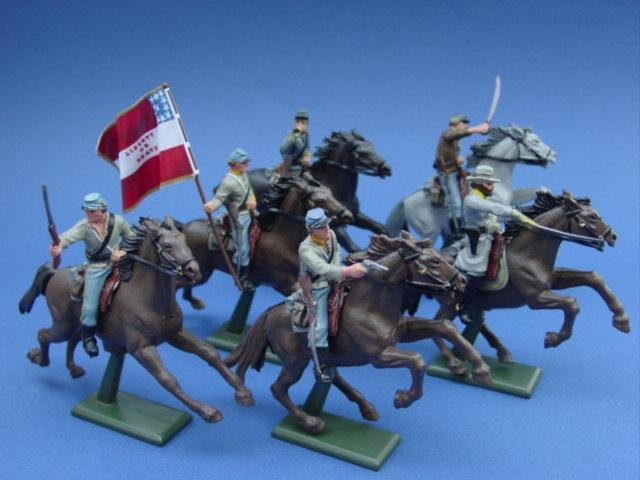 Often thought of being in Arizona, Fort Yuma was actually on the west side of the Colorado River in California.
Often thought of being in Arizona, Fort Yuma was actually on the west side of the Colorado River in California.
The initial Confederate successes in Arizona turned against them due to the efforts of a Union general by the name of James H. Carleton, .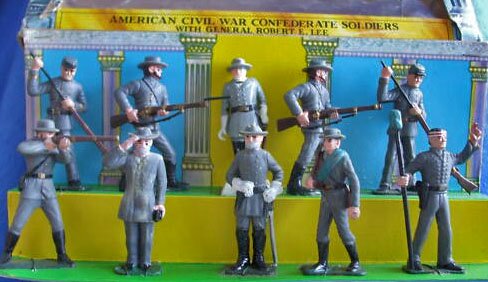 In 1862 Carleton marched the 1st California Volunteers from Fort Yuma eastward toward Texas. He linked up with Union General Canby in New Mexico and the Confederate threat in the territory was largely eliminated. It was during this expedition that the Battle of Picacho Pass took place. On April 15th, 1862 twelve troopers and a scout of the 1st California Volunteer Cavalry led by a Lt. James Barrett was scouting the pass looking for rebels. They came across three Confederate pickets and, against his orders to wait for the main Union column to join him, attacked the pickets. Barrett failed to see seven other Confederates hiding nearby and when they opened fire Barrett and two of his men were killed. Barrett made the same mistake that George Armstrong Custer made 14 years later but on a much smaller scale. After the ninety minute fight both the Union cavalry and the rebels retreated.
In 1862 Carleton marched the 1st California Volunteers from Fort Yuma eastward toward Texas. He linked up with Union General Canby in New Mexico and the Confederate threat in the territory was largely eliminated. It was during this expedition that the Battle of Picacho Pass took place. On April 15th, 1862 twelve troopers and a scout of the 1st California Volunteer Cavalry led by a Lt. James Barrett was scouting the pass looking for rebels. They came across three Confederate pickets and, against his orders to wait for the main Union column to join him, attacked the pickets. Barrett failed to see seven other Confederates hiding nearby and when they opened fire Barrett and two of his men were killed. Barrett made the same mistake that George Armstrong Custer made 14 years later but on a much smaller scale. After the ninety minute fight both the Union cavalry and the rebels retreated.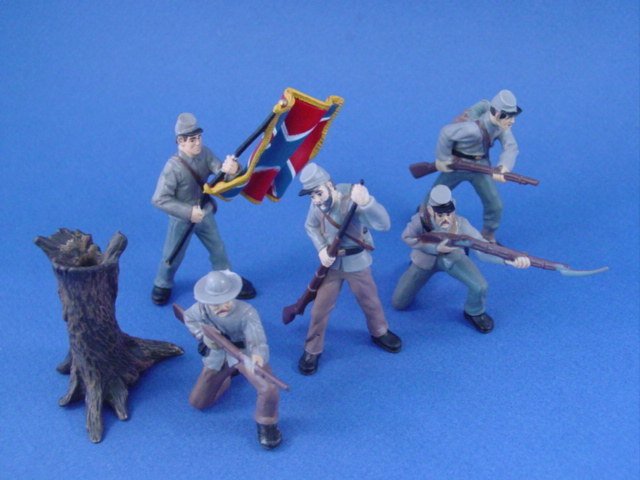 The rebels retreated east to Tucson and warned of the advancing Union forces. Rather than stay and fight, the Confederates retreated eastward and left the strategic town of Tucson wide open for Union occupation.
The rebels retreated east to Tucson and warned of the advancing Union forces. Rather than stay and fight, the Confederates retreated eastward and left the strategic town of Tucson wide open for Union occupation.
Often times when people think of the Civil War they tend to recall the great battles in the east such as Gettysburg, Shiloh and Appomattox. There was however a fair amount of activity in the southwest. Texas as an example sympathized with the Confederacy and fielded a cavalry which battled Union forces mostly in it's own territory and in Arkansas. The Territory of New Mexico's largest battle was at Glorietta Pass in 1862 southeast of Santa Fe where Colorado Union volunteers defeated a Confederate force trying to advance north.
What was recognized as the westernmost battle of the Civil War occurred on April 15th, 1862 at Picacho Pass
That extreme southwest corner of the continent, while far removed from Dixie, was a Confederate sympathizer stronghold. The majority of the people who had migrated there were from the Old South and from Texas. The area was fairly neglected by the federal government and for the most part lawless so there were few reasons for strong allegiance to the Union.
John Robert Bayler, was a key Confederate military figure in the New Mexico Territory. In 1861 he organized troops to fight southwest Union forces and after some success overtaking Union outposts declared himself military governor of the new Arizona Territory, which represented the southern part of present day New Mexico and Arizona.
Baylor appointed a cabinet and the Confederate Congress confirmed his position. He referred to Tucson as the western capitol of the Arizona Territory and Mesilla the eastern capitol. . The image below is of mid 1800's Tucson.
One big problem however after driving the Union forces out was that there was no protection for the settlers from the fierce Apaches.
 they had even more opportunities to do so. The Apache problem was a major concern of Baylor's and this is where he made, what many believe, was the most controversial decision of his military career.
they had even more opportunities to do so. The Apache problem was a major concern of Baylor's and this is where he made, what many believe, was the most controversial decision of his military career.After Baylor succeeded in driving out much the Union force from the southern part of the territory and establishing his own government he had his hands full keeping them out. He requested reinforcements but they weren't sent. Concerning his other problem, he ordered his commanders to seek treaties with the Apaches but without much success. In March of 1862, after being totally frustrated, he ordered his commanders to bring together as many Indians as possible under the guise of peace and friendship and gifts, separate the women and children, and when the time was right slaughter all the males. It's not clear how many of his commanders obeyed these orders. Certainly there were mixed feelings within the ranks.
As the story goes, when Confederate President Jefferson Davis heard of the extermination orders issued by Baylor, he immediately relieved him of both his military and civilian commands. Davis went as far as revoking Baylor's military commission.
There was an overall Confederate strategy in annexing the southern New Mexico Territory. Firstly, it was westerly adjacent to Confederate Texas. Secondly, it offered an entrance into southern California thus a possible port on the Pacific Ocean. California became the 31st state in 1850 but had a secessionist movement of it's own going on particularly in the Los Angeles area..
 In fact the legislature approved a bill for southern California secession but Union forces prevented it's implementation. Below is an image of a California secessionist flag.
In fact the legislature approved a bill for southern California secession but Union forces prevented it's implementation. Below is an image of a California secessionist flag.Union forces were able to quell the southern California movement after their secessionist militia went east to fight in Texas. Several Union bases were established in southern California, one of them being Fort Yuma. It's purpose was to check Confederate advances into California and to launch expeditions eastward.
 Often thought of being in Arizona, Fort Yuma was actually on the west side of the Colorado River in California.
Often thought of being in Arizona, Fort Yuma was actually on the west side of the Colorado River in California.The initial Confederate successes in Arizona turned against them due to the efforts of a Union general by the name of James H. Carleton, .
 In 1862 Carleton marched the 1st California Volunteers from Fort Yuma eastward toward Texas. He linked up with Union General Canby in New Mexico and the Confederate threat in the territory was largely eliminated. It was during this expedition that the Battle of Picacho Pass took place. On April 15th, 1862 twelve troopers and a scout of the 1st California Volunteer Cavalry led by a Lt. James Barrett was scouting the pass looking for rebels. They came across three Confederate pickets and, against his orders to wait for the main Union column to join him, attacked the pickets. Barrett failed to see seven other Confederates hiding nearby and when they opened fire Barrett and two of his men were killed. Barrett made the same mistake that George Armstrong Custer made 14 years later but on a much smaller scale. After the ninety minute fight both the Union cavalry and the rebels retreated.
In 1862 Carleton marched the 1st California Volunteers from Fort Yuma eastward toward Texas. He linked up with Union General Canby in New Mexico and the Confederate threat in the territory was largely eliminated. It was during this expedition that the Battle of Picacho Pass took place. On April 15th, 1862 twelve troopers and a scout of the 1st California Volunteer Cavalry led by a Lt. James Barrett was scouting the pass looking for rebels. They came across three Confederate pickets and, against his orders to wait for the main Union column to join him, attacked the pickets. Barrett failed to see seven other Confederates hiding nearby and when they opened fire Barrett and two of his men were killed. Barrett made the same mistake that George Armstrong Custer made 14 years later but on a much smaller scale. After the ninety minute fight both the Union cavalry and the rebels retreated. The rebels retreated east to Tucson and warned of the advancing Union forces. Rather than stay and fight, the Confederates retreated eastward and left the strategic town of Tucson wide open for Union occupation.
The rebels retreated east to Tucson and warned of the advancing Union forces. Rather than stay and fight, the Confederates retreated eastward and left the strategic town of Tucson wide open for Union occupation.lice
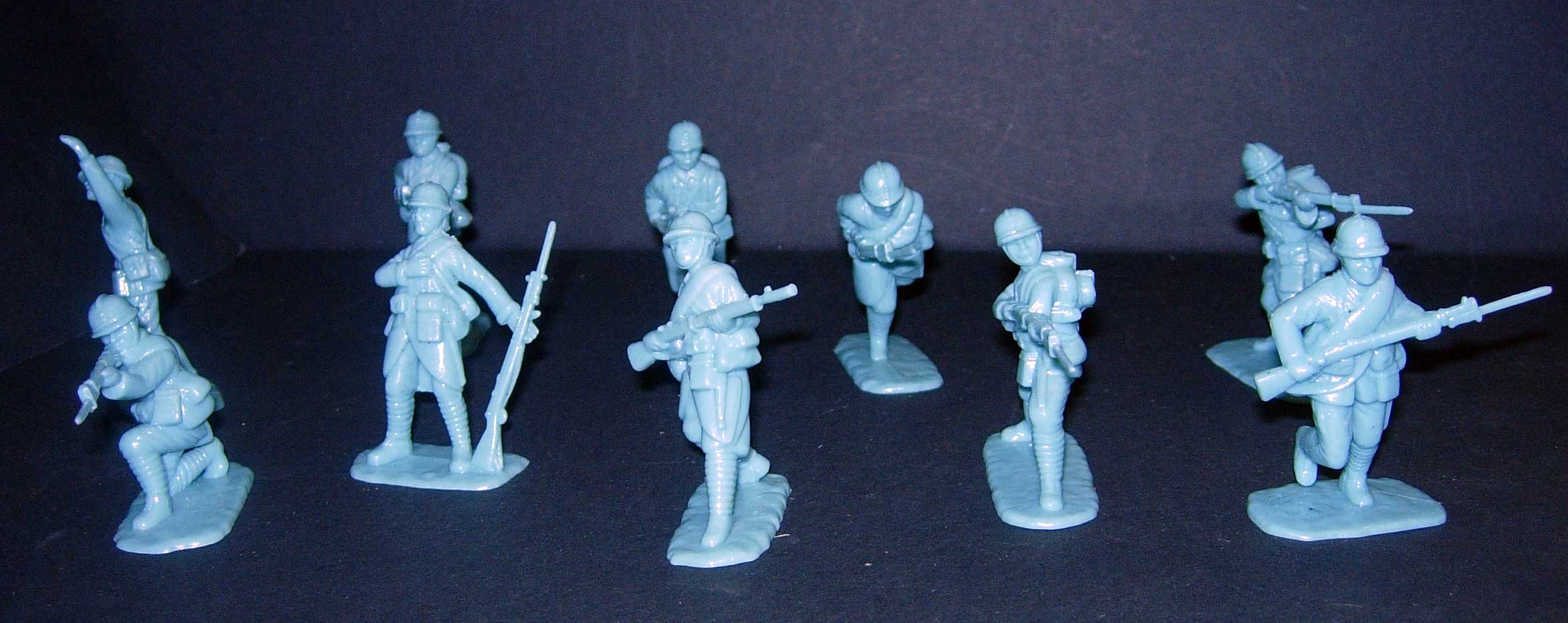
Reading Blaise Cendrars is like stepping into another universe Maybe the greatest ww1 book was lice by cendrars, an incredible read and beating much of the rest as regards war books, its the story of his service in the french army at the front.
Maybe the greatest ww1 book was lice by cendrars, an incredible read and beating much of the rest as regards war books, its the story of his service in the french army at the front.
. His fiction is unlike anything else I've ever read. His poetry influenced the mighty Guillaume Apollinaire and helped shape the face of modernism. But it is his mockery of biographical detail and the very notion of literature that fascinates me the most. If, like me, you're not a fan of autobiography, then Blaise Cendrars is the memoirist for you
 Maybe the greatest ww1 book was lice by cendrars, an incredible read and beating much of the rest as regards war books, its the story of his service in the french army at the front.
Maybe the greatest ww1 book was lice by cendrars, an incredible read and beating much of the rest as regards war books, its the story of his service in the french army at the front.
. His fiction is unlike anything else I've ever read. His poetry influenced the mighty Guillaume Apollinaire and helped shape the face of modernism. But it is his mockery of biographical detail and the very notion of literature that fascinates me the most. If, like me, you're not a fan of autobiography, then Blaise Cendrars is the memoirist for you

Blaise Cendrars - or the "son of Homer" as John Dos Passos called him - is himself a strange kind of fiction: born in La Chaux-de-Fonds of a Scottish mother and Swiss father, he claimed that he left home aged 15 to work in Russia during the revolution of 1905. He was a bee-keeper, a film maker, a chef, a picture-house pianist, a watchmaker, and a traveller with drunken gypsies.
He spent the first world war fighting with the French foreign legion, where he lost his arm in combat, became an art critic, befriended Picasso, sailed the seven seas, shovelled coal in China, amassed and lost huge fortunes and had his own gossip column in a Hollywood newspaper. Nobody knows how much of this is actually true. Though he certainly lost an arm in the first world war, it is possible Blaise Cendrars was pulling more than one or two legs.
shovelled coal in China, amassed and lost huge fortunes and had his own gossip column in a Hollywood newspaper. Nobody knows how much of this is actually true. Though he certainly lost an arm in the first world war, it is possible Blaise Cendrars was pulling more than one or two legs.

He spent the first world war fighting with the French foreign legion, where he lost his arm in combat, became an art critic, befriended Picasso, sailed the seven seas,
 shovelled coal in China, amassed and lost huge fortunes and had his own gossip column in a Hollywood newspaper. Nobody knows how much of this is actually true. Though he certainly lost an arm in the first world war, it is possible Blaise Cendrars was pulling more than one or two legs.
shovelled coal in China, amassed and lost huge fortunes and had his own gossip column in a Hollywood newspaper. Nobody knows how much of this is actually true. Though he certainly lost an arm in the first world war, it is possible Blaise Cendrars was pulling more than one or two legs.
In fact, Blaise Cendrars isn't even his real name. His real name is Frédéric Louis Sauser. Blaise Cendrars is a bastardisation of "braise" (embers) and "cendres" (ashes) with "ars" (art) thrown in for good measure. Blaise Cendrars dances on the ashes of outmoded literary styles to create his own pioneering art. Fire is a repeated image throughout his work and it is this insouciance and dismissal of all that came before him that is elementary to his own philosophy: be different and forge the new.


His most famous "biographical" work is the war memoirs tetralogy, consisting of the Astonished Man (L 'Homme foudroyé, 1945), Lice (La main coupée, 1946), Planus (Bourlinguer, 1948), and Sky (Le Lotissement du ciel, 1949). These aren't your average war memoirs, they are the strangest and most surreal I have ever encountered. Encompassing almost 1000 pages they cover subjects from the bizarre and the surreal: pimps, wastrels, vagabonds, gypsies, actors, prostitutes, and thieves figure in abundance. It doesn't matter to me if some of it isn't true.

The Astonished Man blew me away when I first read it. It is Blaise Cendrars at his very best, a smorgasbord of artists, thieves, and brain-dead sergeants which hoodwinks the reader into believing this magical and horrifying world. It is gonzo journalism 30 years before Thompson and Wolfe, but, unlike most gonzo journalists, Cendrars could write a mouth-wateringly beautiful sentence to boot. We don't care for fact when we read him. All that nonsense is dismissed. We are hypnotised.
"I am haunted by no phantoms. It is rather that the ashes I stir up contain the crystallization that hold the image (reduced or synthetic) of the living and impure beings that they constituted before the intervention of the fire. If life has a meaning, this image (from the beyond?) has perhaps some significance. That is what I should like to know. And it is why I write." 

For me, the best memoirists are those who know that all biography is fiction. Cendrars eschews biographical detail and morphs fact and fiction into an elaborate hoax that is both authentic and illusory - the reader is press-ganged and taken along for the ride. Literature should never be anchored or locked. Who needs to be bogged down with biographical fact when such writers hold the keys to our imagination?
Sunday, 14 August 2011
the legion in the 30s
Captain Gallant of the Foreign Legion was a half-hour black-and-white television series about the French Foreign Legion starring Buster Crabbe in the title role. Crabbe's real-life son Cullen Crabbe played the Legion mascot, with cowboy sidekick Fuzzy Knight playing himself as Legion comedy relief. The series premiered on NBC on 13 February 1955 and ended its first run with the 65th episode shown on 7 December 1957[. It was shown for many years in syndication on American television under the title Foreign Legionnaire.
The series premiered on NBC on 13 February 1955 and ended its first run with the 65th episode shown on 7 December 1957[. It was shown for many years in syndication on American television under the title Foreign Legionnaire. the stirring adventure stories written by British author P.C. Wren in the 1930's, the Beau
the stirring adventure stories written by British author P.C. Wren in the 1930's, the Beau  Geste tales, in which a wrongly accused English gentleman does the decent thing, and takes the guilt for a crime he did not commit, so as to save a lady's honour.
Geste tales, in which a wrongly accused English gentleman does the decent thing, and takes the guilt for a crime he did not commit, so as to save a lady's honour.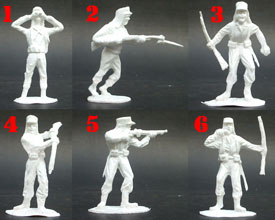
Not being a complete mug, he then evades the long arm of British justice, skips to France, and signs up in the feared and brutal Légion Étrangère. Passing through the callous brutality of basic training, he is posted to Morocco to fight in the Rif wars against the Arabs.
He ends up in the dreaded outpost of Fort Zinderneuf, run by brutal officers and sergeants, where discipline is basic and straight to the point. A deserter is recaptured by local Arabs - who receive a cash bounty for bringing such men back alive - and punished by being buried in the sand up to his neck, and left in the blazing desert sun for three days. (Geste is beaten by the sergeant for sneaking him some water). When the hostile Tuareg Arabs (D'regs) attack the fort in force and nearly overwhelm it, Beau Geste has the idea of propping dead men up on the walls with their rifles, to make the fort look more strongly defended than it really is. (Compare this to "Beau Nidle" taking the idea a step further) The idea that "men join the Legion to forget" was coined for these books...the legionaaires above could easily be converted to 30's ones by making the kepi less pronounced and paint job.
When the hostile Tuareg Arabs (D'regs) attack the fort in force and nearly overwhelm it, Beau Geste has the idea of propping dead men up on the walls with their rifles, to make the fort look more strongly defended than it really is. (Compare this to "Beau Nidle" taking the idea a step further) The idea that "men join the Legion to forget" was coined for these books...the legionaaires above could easily be converted to 30's ones by making the kepi less pronounced and paint job..jpg)
 the stirring adventure stories written by British author P.C. Wren in the 1930's, the Beau
the stirring adventure stories written by British author P.C. Wren in the 1930's, the Beau  Geste tales, in which a wrongly accused English gentleman does the decent thing, and takes the guilt for a crime he did not commit, so as to save a lady's honour.
Geste tales, in which a wrongly accused English gentleman does the decent thing, and takes the guilt for a crime he did not commit, so as to save a lady's honour.
Not being a complete mug, he then evades the long arm of British justice, skips to France, and signs up in the feared and brutal Légion Étrangère. Passing through the callous brutality of basic training, he is posted to Morocco to fight in the Rif wars against the Arabs.
He ends up in the dreaded outpost of Fort Zinderneuf, run by brutal officers and sergeants, where discipline is basic and straight to the point. A deserter is recaptured by local Arabs - who receive a cash bounty for bringing such men back alive - and punished by being buried in the sand up to his neck, and left in the blazing desert sun for three days. (Geste is beaten by the sergeant for sneaking him some water).
 When the hostile Tuareg Arabs (D'regs) attack the fort in force and nearly overwhelm it, Beau Geste has the idea of propping dead men up on the walls with their rifles, to make the fort look more strongly defended than it really is. (Compare this to "Beau Nidle" taking the idea a step further) The idea that "men join the Legion to forget" was coined for these books...the legionaaires above could easily be converted to 30's ones by making the kepi less pronounced and paint job.
When the hostile Tuareg Arabs (D'regs) attack the fort in force and nearly overwhelm it, Beau Geste has the idea of propping dead men up on the walls with their rifles, to make the fort look more strongly defended than it really is. (Compare this to "Beau Nidle" taking the idea a step further) The idea that "men join the Legion to forget" was coined for these books...the legionaaires above could easily be converted to 30's ones by making the kepi less pronounced and paint job..jpg)
Most of the stories recounted in the books have some basis in fact; France (and neighbour Spain) co-operated in wars in their North African colonies (Algeria, Tunisia and the Moroccos) against Tuareg Arabs fighting an Islamic Jihad to throw out the infidels.below BMC conversions Both countries had Foreign Legions composed of the lost and unlucky which were used for preference in these colonial actions. While the French had some success in supressing Arab insurrection in Algeria, the Spanish were at first humiliatingly defeated with the loss of up to 30,000 troops. A chain of forts, along the Fort Zinderneuf model, were key to frontier security:
Both countries had Foreign Legions composed of the lost and unlucky which were used for preference in these colonial actions. While the French had some success in supressing Arab insurrection in Algeria, the Spanish were at first humiliatingly defeated with the loss of up to 30,000 troops. A chain of forts, along the Fort Zinderneuf model, were key to frontier security: while the French held theirs against often savage assaults, the Spanish forts fell like dominos to the Moroccan insurrectionists. (Interestingly, the Spanish general who finally held the line in what they could hold of Morocco was one Francisco Franco, a man whose rage and humiliation at colonial defeat led him to start a Civil War...)
while the French held theirs against often savage assaults, the Spanish forts fell like dominos to the Moroccan insurrectionists. (Interestingly, the Spanish general who finally held the line in what they could hold of Morocco was one Francisco Franco, a man whose rage and humiliation at colonial defeat led him to start a Civil War...)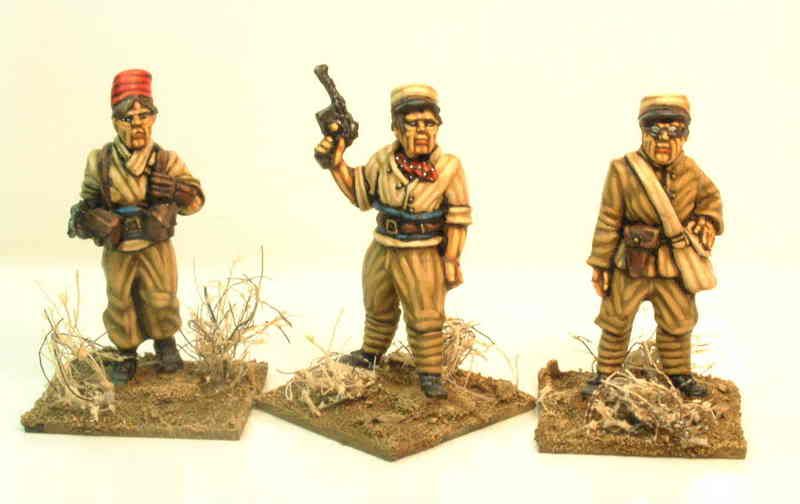
 Both countries had Foreign Legions composed of the lost and unlucky which were used for preference in these colonial actions. While the French had some success in supressing Arab insurrection in Algeria, the Spanish were at first humiliatingly defeated with the loss of up to 30,000 troops. A chain of forts, along the Fort Zinderneuf model, were key to frontier security:
Both countries had Foreign Legions composed of the lost and unlucky which were used for preference in these colonial actions. While the French had some success in supressing Arab insurrection in Algeria, the Spanish were at first humiliatingly defeated with the loss of up to 30,000 troops. A chain of forts, along the Fort Zinderneuf model, were key to frontier security: while the French held theirs against often savage assaults, the Spanish forts fell like dominos to the Moroccan insurrectionists. (Interestingly, the Spanish general who finally held the line in what they could hold of Morocco was one Francisco Franco, a man whose rage and humiliation at colonial defeat led him to start a Civil War...)
while the French held theirs against often savage assaults, the Spanish forts fell like dominos to the Moroccan insurrectionists. (Interestingly, the Spanish general who finally held the line in what they could hold of Morocco was one Francisco Franco, a man whose rage and humiliation at colonial defeat led him to start a Civil War...)
What the Legion called le cafard was an occupational hazard in North Africa: a catatonic, listless, fugue mental state brought on by the sheer monotony of existence in a barren hostile desert. One of its symptoms was loss of memory and amnesia - so perhaps the Klatchian Foreign Legion is not so far off the truth after all...

A final level of association: author George McDonald Fraser was in command of such a fort, in the immediate aftermath of WW2, when North Africa was being administered by the British. His adventures at Fort Zarhuna, the only ex-Foreign Legion fort to be garrisoned by Scottish Highlanders, and which was indeed "attacked" by raiding Arabs, are recounted in McAuslan in the Rough. (A book known to have been read by Terry Pratchett, and part of the background inspiration for the Nac Mac Feegle).

Subscribe to:
Comments (Atom)



 no idea of where this one comes from but its great
no idea of where this one comes from but its great


